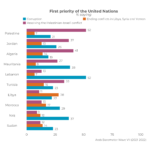In chaos theory, the butterfly effect is the sensitive dependence on initial conditions in which a small change in one state of a deterministic nonlinear system can result in large differences in a later state.
In his 2014 book “The Butterfly Defect”, Oxford Martin School Professor Ian Goldin warned against the increase in systemic risks as a result of globalization, replacing ‘effect’ by ‘defect’ to highlight the risks associated with a highly connected and integrated world. In a chapter on the systemic risk of pandemics, he foreshadowed the crisis we witness today by pointing to the following factors as evidence of how a pandemic can have “profound and potentially catastrophic systemic consequences”:
- The risk of connectivity, due to the density and intensity of connections between humans, and between humans and animals;
- The risk of concentration, as more and more people live in megacities and inequality within cities excludes some from basic services such as sanitation, clean water and medical care;
- The risk of “social” contagion, given the almost instantaneous spread of information and rumours in the age of internet and social media.
A systemic crisis
As the first systemic crisis of the 21st century, the financial crisis of 2008 shed important light on the fragility of an interconnected world. Yet many Arab countries were shielded from the worst consequences by their relative isolation from the global financial system. The COVID-19 pandemic is another story. It has officially spread to nearly every country in the Arab region.
Countries that are reporting no or few cases, such as Libya, Syria, Yemen, Sudan, Somalia, Djibouti, lack the testing capacity. We must act regardless.
We are dealing with a global multidimensional crisis for the first time. In a 2006 Ted talk, epidemiologist Larry Brilliant shared his colleagues’ predictions of a potential pandemic. He said one billion people would get sick, as many as 165 million people would die, there would be a global recession and depression which would cost the global economy USD$1 to $3 trillion. Early estimates of the impact of the current pandemic are consistent with these projections. A United Nations Conference on Trade and Developement report identifies the possibility of a US$2 trillion fallout. And according to early estimates from the Economic and Social Commission for Western Asia, the Arab region is set to lose at least US$42 billion in GDP and at least 1.7 million jobs this year. A prolonged global economic slowdown will adversely affect the Sustainable Development Goals (SDGs), and this pandemic threatens to disrupt sustainable development efforts in all sectors. Measures such as school closures, though a necessary component of the response, are upending every aspect of social and economic life, in ways which ensure vast challenges.
COVID-19 and fragility
In a region already suffering from many protracted and violent conflicts, as well as dealing with a significant numbers of displaced, refugees, and migrants, a pandemic of this scale will deepen pre-existing fragilities in already-vulnerable countries and introduce fragility into middle- and high-income ones. Countries’ levels of preparedness and institutional capacities, as well as the effectiveness of their preparation and response will largely determine how they emerge. According to the Global Health Security Index, an assessment of global health security capabilities, the Arab region has an average ranking of 122 out of 195.
Governments matter
The Arab Barometer has repeatedly shown there is low trust in governments. Meanwhile lack of reliable data makes it harder to respond to the crisis, starting with the challenge of transparent communication with the public. According to the Open Data Inventory, data on health facilities is poorly covered in low-income Arab countries such as Mauritania and Djibouti, but also in high and middle-income countries such as Lebanon, Libya, and the United Arab Emirates.
But the situation in fragile countries where violence is raging remains the most worrying. On March 23, the Secretary-General of the United Nations called for a global ceasefire in the face of COVID-19. Countries such as Syria have seen years of protracted conflict destroy infrastructure and decimate their health systems. In 2018 alone, there were 308 attacks on health care facilities reported in the State of Palestine, the highest number globally. There were 257 in Syria; 53 in Yemen and 47 in Libya. Although some of these countries are less connected to global traffic, which might insulate them temporarily, once community transmission becomes a reality, they will have neither the tools nor the capacity to prevent and respond effectively. The pandemic also puts food security at risk, especially for those who are dependent on humanitarian aid. hTat includes 20 million Yemenis, 6.5 million Syrians, 1.6 million Somalis and 5.8 million Sudanese.
A society-wide response
The pandemic has highlighted the importance of having an effective government that is able to mobilize quickly the entirety of its institutions and to engage the private sector, the media and civil society. Religious leaders hold significant authority in many Arab countries and using their influence can prove vital to community engagement. Social media and digital technology are emerging strongly as education, government services, and businesses all move online. Adopting forecasting and early warning tools can also allow countries to better prevent and prepare for future epidemics, which are expected to occur more frequently. With close to 50 percent of its population still not using the internet, it’s imperative to speed up digitalization in the region.
There are still many unknowns in this unfolding tragedy but what is certain is that this unique crisis will require new thinking, as well as collective action and solidarity from governments, citizens, and international organizations. By supporting countries during all three stages of the pandemic–preparing, responding and recovering–UNDP is committed to help them mitigate the immediate short-term consequences of COVID-19 while building the resilience to face future crises.
Read original article at UNDP

